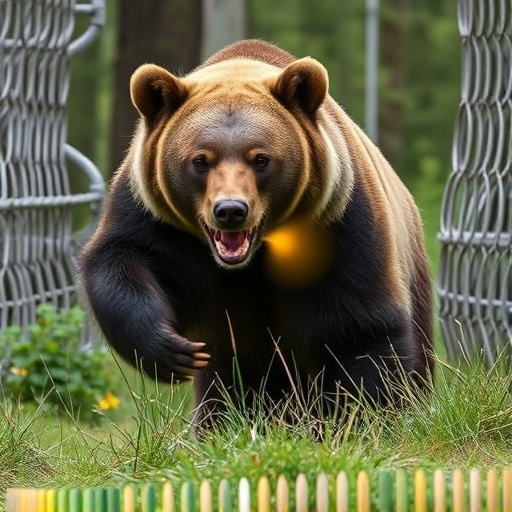Bear spray, a powerful deterrent for aggressive bears, relies on capsaicin-based ingredients and proper application techniques. Understanding wind direction is crucial for both effectiveness and safety. Tailwinds can carry the spray back towards the user, while headwinds may reduce its range. Users should practice in controlled settings, scan surroundings for bear activity, aim at the bear's face and eyes, be aware of different wind scenarios, store bear spray securely, and maintain regular checks on expiration dates to maximize protection.
“Enhance your outdoor safety with a comprehensive guide to bear deterrent spray, focusing on maximum range protection. Learn about the effectiveness of bear spray and its active ingredients, understanding how wind direction significantly impacts its reach. Discover crucial safety tips for usage and storage, ensuring your peace of mind in bear country. Explore best practices for optimal protection in diverse environments, armed with knowledge to navigate encounters effectively.”
- Understanding Bear Spray: Effectiveness and Active Ingredients
- Factors Affecting Bear Spray Range: Wind Direction and Other Considerations
- Safety Tips for Proper Bear Spray Usage and Storage
- Maximizing Protection: Best Practices for Bear Deterrent Spray in Different Environments
Understanding Bear Spray: Effectiveness and Active Ingredients
Bear spray, also known as bear deterrent spray or pepper spray for bears, is a powerful tool designed to protect individuals from aggressive bear encounters in wild environments. When faced with a potential threat from bears, such as grizzly or black bears, having this spray on hand can significantly increase safety margins. Understanding its effectiveness and the factors that influence its performance is crucial when considering it as a bear deterrent.
The active ingredients in bear spray are typically capsaicin-based, derived from chili peppers. These irritants create a burning sensation when they come into contact with the bear’s eyes, nose, and mouth, causing the animal to flee. The spray’s effectiveness relies on proper usage, which includes aiming for the bear’s face and maintaining a safe distance. Wind direction is a critical safety tip; it should be taken into account when deciding whether to use bear spray, as blowing the spray back towards the user could result in direct exposure to the capsaicin, causing discomfort or even respiratory issues. Knowing how to use it efficiently can ensure maximum protection within its recommended range.
Factors Affecting Bear Spray Range: Wind Direction and Other Considerations
The effectiveness of bear deterrent spray, or bear spray for short, is influenced by several factors beyond the product’s quality and concentration. One of the most significant variables is the wind direction. When applying bear spray, aiming towards the face and respiratory system of an approaching bear is crucial. However, the wind can alter this strategy. A tailwind can carry the spray directly back towards you, rendering it less effective or even counterproductive. Conversely, a headwind may spread the spray further, increasing its reach but making precise targeting more challenging.
Understanding these dynamics offers valuable safety tips for those venturing into bear country. It emphasizes the importance of assessing wind conditions before deploying bear spray and suggests adapting your technique accordingly. Additionally, it encourages users to practice with their spray in controlled settings to understand its range and effectiveness under various wind scenarios, ensuring a safer encounter should they face a bear in the wild.
Safety Tips for Proper Bear Spray Usage and Storage
When using bear spray, understanding the wind direction is crucial for maximum effectiveness and safety. Always scan the area for any potential bear activity before deployment. Aim for the bear’s face and eyes, as this is where the spray will have the greatest impact. Keep in mind that a strong headwind can reduce the spray’s range and accuracy, while a tailwind might blow the spray back towards you.
Proper storage is equally vital. Bear spray should be stored in an accessible yet secure location, away from direct sunlight and extreme temperatures. Ensure it’s out of reach of children and pets. Regularly check expiration dates and practice handling the canister to familiarize yourself with its operation, ensuring you’re ready if a bear encounter occurs.
Maximizing Protection: Best Practices for Bear Deterrent Spray in Different Environments
To maximize the protection offered by bear deterrent spray, understanding and adhering to safety tips based on environmental factors is crucial. When using bear spray, the wind direction plays a significant role in its effectiveness. It’s recommended to apply the spray into the wind, ensuring that the bearing of the breeze carries the spray towards the approaching bear. This strategic application can significantly enhance the range and impact of the deterrent.
Different environments necessitate varying approaches. In open spaces with little cover, spraying in a zigzag pattern can increase the likelihood of reaching the bear. Conversely, in dense forests or rugged terrain, targeting high points like trees or overhangs can be beneficial, as bears tend to avoid these areas once sprayed. Regularly testing and refreshing the spray’s potency is also essential, especially after prolonged storage or exposure to varying temperatures, to ensure maximum protection when needed.
Bear deterrent spray is a valuable tool for outdoor enthusiasts navigating environments with bear populations. Understanding its effectiveness, active ingredients, and range, as well as safe usage practices, can significantly enhance personal safety. By considering wind direction and implementing best practices tailored to specific environments, individuals can maximize protection when facing potential bear encounters. Remember, knowledge of proper safety tips and responsible usage are key to ensuring a more secure outdoor experience in areas where bears reside.
